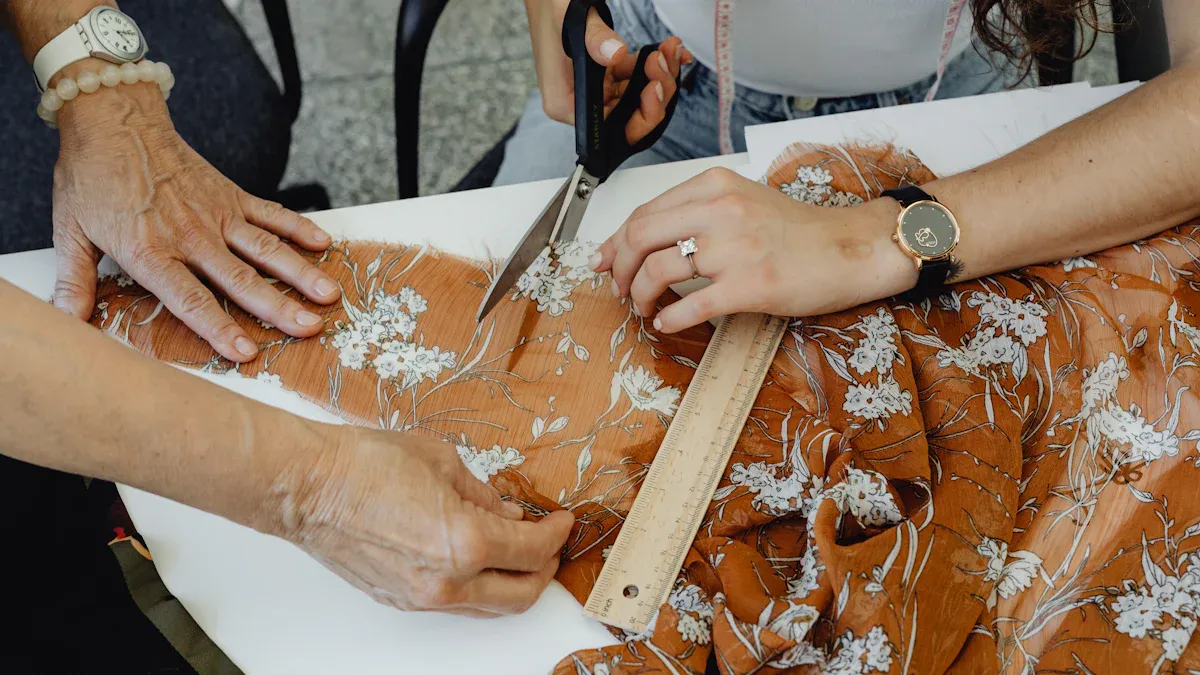
Predictive analytics uses machine learning to forecast fabric performance. It analyzes data to predict the shrinkage of a fabric after washing. This technology empowers manufacturers to move beyond slow, traditional laboratory testing. The new approach to testing helps control fabric shrinkage issues before production begins.
This shift enables the proactive design of high-performance fabric. It allows for creating precise care instructions from the outset, ensuring minimal shrinkage and superior fabric quality.
Understanding Fabric Shrinkage

Fabric shrinkage is a critical factor that determines a garment's quality and lifespan. The impact of shrinkage can lead to poor fit and customer dissatisfaction. Understanding why it happens is the first step toward controlling it.
The Basics of Material Instability
A fabric's tendency to shrink stems from its fundamental properties. The primary drivers of fabric shrinkage are fiber type and construction. Each material responds differently to heat, moisture, and agitation during washing.
- Natural Fibers (Cotton, Wool): These fibers have high water absorption. They swell when wet and contract as they dry, which causes significant shrinkage.
- Synthetic Fibers (Polyester, Nylon): These manufactured fibers absorb very little water. Their structure is heat-set during production, giving them excellent dimensional stability and resistance to shrinkage.
- Blended Fabrics (Cotton-Polyester): Blends combine the comfort of natural fibers with the stability of synthetics, resulting in much lower shrinkage.
Fabric construction also plays a key role. Loosely knitted fabrics have more room for yarns to shift and tighten, increasing the potential for shrinkage. In contrast, tightly woven fabrics offer greater stability due to their rigid structure.
Traditional Fabric Shrinkage Test Methods
For decades, the industry has relied on physical testing to measure fabric shrinkage. The main purpose of shrinkage testing is to quantify how much a fabric will change size after laundering. The role of shrinkage testing is to provide data for quality control and care label instructions. A standard fabric shrinkage test, like AATCC 135, involves marking a fabric sample, washing and drying it under controlled conditions, and then measuring the distance between the marks to calculate the percentage of shrinkage.
While effective, this manual fabric shrinkage test process can be slow. Modern digital tools now complement traditional shrinkage testing. Image analysis systems, for example, can measure shrinkage with incredible precision, reducing human error and delivering results that are often more accurate than manual measurements. This evolution in testing sets the stage for more advanced predictive methods.
The Power of Predictive Analytics

Predictive analytics transforms fabric development from a reactive process into a proactive science. It uses data to build models that forecast fabric shrinkage with remarkable accuracy. This approach allows manufacturers to digitally simulate a fabric shrinkage test, saving time and resources. The core of this technology lies in gathering the right data and applying the right algorithms.
Essential Data Inputs
A predictive model is only as good as the data it receives. To accurately predict fabric shrinkage, algorithms require detailed information about the fabric's entire lifecycle, from raw fiber to finished product. Key data inputs include:
- Fiber Composition: This is the most basic input. The model needs to know the exact fiber type (e.g., cotton, polyester, viscose) and the percentage of each fiber in a blend.
- Fabric Construction: The physical structure of the fabric is critical. Models analyze parameters like weave or knit type, thread density, and yarn count. Research shows that for certain fabrics, stitch length and stitch type can be more influential on shrinkage than yarn density alone.
- Manufacturing Processes: The journey a fabric takes through production heavily influences its stability. Data on dyeing methods, finishing chemicals, and mechanical treatments provide crucial context for predicting shrinkage.
Finishing treatments, such as resin applications, directly impact a fabric's dimensional stability. Capturing this process data is essential for building a reliable model for shrinkage control and moving beyond simple physical testing.
Predicting Shrinkage with Algorithms
Once the data is collected, machine learning algorithms get to work. These models learn the complex relationships between fabric properties and their reaction to washing. This digital testing process can predict shrinkage outcomes with high precision.
Different algorithms serve different purposes. Regression models are used to predict a specific numerical value. For example, an Artificial Neural Network (ANN) can process inputs like yarn count and spandex percentage to forecast that a fabric will have 3.5% shrinkage in the warp direction. These models are especially effective for complex materials like stretch denim, where many variables affect the final shrinkage. The accuracy of these predictions is measured with metrics that calculate the error between forecasted and actual shrinkage results from testing.
Classification models offer another approach. Instead of predicting an exact number, they assign a fabric to a predefined category. For instance, a model could classify a fabric's washability as "Low Shrinkage," "Moderate Shrinkage," or "High Shrinkage." This helps brands quickly assess if a fabric meets their quality standards for a particular product line. This advanced form of shrinkage testing empowers designers to make smarter choices early in the development cycle.
Industry Applications and Benefits
The adoption of predictive analytics offers significant advantages across the textile supply chain. This technology moves the industry from reactive problem-solving to proactive quality assurance. It provides powerful tools for both fabric producers and the brands that depend on them.
For Fabric Manufacturers
Fabric manufacturers can use predictive models to refine their operations, enhance product quality, and drive innovation. This data-driven approach creates a more efficient and profitable production environment.
- Accelerated Research & Development: Digital simulation of wash testing allows manufacturers to explore new material blends virtually. They can assess the potential shrinkage of a new fabric design without creating physical samples. This speeds up the innovation cycle for developing materials with superior stability.
- Optimized Material Blends: Models help engineers determine the ideal combination of fibers to achieve specific performance targets. They can balance factors like comfort, cost, and dimensional stability to create a better final fabric. This precision ensures the end product meets client specifications for shrinkage and durability.
- Reduced Waste and Costs: Predictive quality control is a game-changer for reducing waste. By analyzing real-time production data, manufacturers can foresee and prevent issues like excessive shrinkage before they ruin an entire batch. For example, textile manufacturer Welspun India used a predictive system to cut raw material wastage by 15%. The system monitored machine data to predict quality problems, leading to a sharp drop in post-production complaints about shrinkage and other defects. This proactive stance on quality saves both materials and money.
This shift transforms fabric production. It empowers manufacturers to guarantee a higher level of fabric quality and stability from the very beginning, making their products more attractive to apparel brands.
For Apparel Brands and Retailers
For apparel brands and retailers, fabric stability is directly linked to brand reputation and customer loyalty. Predictive analytics provides the assurance they need to deliver a consistently high-quality garment.
- Ensured Quality Consistency: Brands can use shrinkage predictions to enforce strict quality standards. They can ensure that every roll of fabric from every supplier offers the same level of performance. This consistency is vital for maintaining the fit and feel of a garment after washing, which protects brand integrity. The high accuracy of these models, which can explain 90 percent of the variation in shrinkage data, gives brands confidence in their fabric choices.
- Accurate Care Label Generation: Precise shrinkage forecasts enable the creation of accurate care labels. When a brand knows exactly how a garment will behave, it can provide clear washing instructions. This helps customers care for their garment correctly, extending its life and improving overall satisfaction. Proper care based on reliable data is key to garment durability.
- Improved Supplier Selection: Data on fabric stability becomes a powerful tool for managing the supply chain. Brands can evaluate potential suppliers based on their proven ability to produce fabric with minimal shrinkage. This data-driven vetting process helps brands build partnerships with manufacturers who are committed to high quality standards. Ultimately, a stable, reliable fabric reduces the risk of customer returns related to poor wash performance, protecting the brand's bottom line and reputation. A quality garment starts with quality fabric.
Challenges and Future Outlook
Adopting predictive analytics presents both challenges and exciting opportunities. While the technology promises to revolutionize how the industry manages fabric shrinkage, implementation requires careful planning. The future, however, points toward even more intelligent and integrated systems for fabric and garment development.
Implementation Hurdles
The primary obstacle to implementing predictive analytics is data. The quality of shrinkage predictions depends entirely on the quality of the input data. Many manufacturers face significant hurdles in this area.
- Inconsistent Data: Manual inspections are subjective. Different workers may report defects differently, creating inconsistent data that harms model accuracy. This makes predicting fabric shrinkage difficult.
- High Initial Costs: Setting up the necessary infrastructure is a major investment. Companies must install IoT sensors on machinery, ensure reliable network connectivity, and integrate data into a central platform for analysis.
- Legacy Systems: Many mills rely on paper-based documentation or outdated spreadsheets. These systems make it difficult to retrieve historical data needed to train models for predicting fabric shrinkage.
Overcoming these issues is crucial. Without standardized, high-quality data, even the best algorithms will fail to deliver accurate forecasts for garment shrinkage. The goal is to create a reliable system for shrinkage control.
The Future of Fabric Prediction
The future of fabric analytics extends far beyond predicting shrinkage. Emerging technologies are creating a more holistic approach to quality control. AI models are now learning to forecast other fabric issues like pilling and colorfastness, giving a complete performance preview. The ultimate goal is to control every aspect of fabric shrinkage and durability.
A key innovation is the "digital twin." This is a virtual replica of a physical fabric or garment. This digital copy stores all data about the garment, from its fiber origin to its real-world performance. Brands can use this information to track a garment's lifecycle, improve future designs, and even provide customers with detailed care instructions. This technology helps manage the expected shrinkage of a garment.
Advancements in AI are also making these tools more accessible. New techniques allow models to learn from smaller datasets, reducing the need for massive historical records. This will enable smaller companies to adopt predictive analytics for shrinkage and improve their fabric quality. This evolution promises a future where every garment is designed with predictable performance, ensuring minimal shrinkage and maximum customer satisfaction.
Predictive analytics offers a data-driven method for managing fabric shrinkage. This technology helps manufacturers reduce waste, accelerate innovation, and ensure superior fabric quality. It aligns production with sustainability goals for a better fabric. The industry is shifting from simple testing to proactive shrinkage control. This change guarantees a higher quality fabric and transforms how every fabric is designed, ensuring excellent quality and performance from the start.
FAQ
What is predictive analytics for fabric?
Predictive analytics uses machine learning and data. It forecasts how a fabric will perform after washing. This technology predicts outcomes like shrinkage before production starts. It helps manufacturers save time and resources.
What data does this technology need?
The models require specific data points for accurate predictions. Key inputs include:
- Fiber type (e.g., cotton, polyester)
- Fabric construction details
- Manufacturing process information
Good data ensures reliable shrinkage forecasts.
How does this help apparel brands?
Brands use this technology to ensure consistent quality. It helps them select stable fabrics from suppliers. This process leads to accurate care labels and fewer customer returns from poor wash performance. A quality garment starts with a quality fabric.
Can it predict more than just shrinkage?
Yes, the technology is evolving. Future models will predict other fabric issues. These include pilling, color fading, and overall durability. This gives a complete preview of fabric quality and performance over time.
See Also
Revolutionizing Textile Operations: AI-Powered Predictive Maintenance for 2025 Efficiency
Achieving Equilibrium: Predictive Analytics Harmonizes Fashion Supply and Consumer Demand
Future-Proofing Fashion Retail: Advanced Predictive Models for Success by 2025
Optimizing Inventory: Predictive Analytics Streamlines Retail Re-stocking Strategies for 2025
Unlocking Precision: Leveraging Sales Data for Highly Accurate Fashion Trend Forecasts